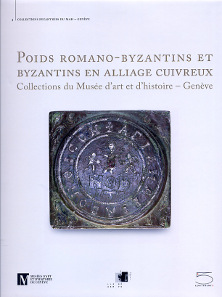by Ursula Kampmann
translated by Annika Backe
May 21, 2015 – The Musée d’art et d’histoire de Genève harbors a treasure in its storage. It is the collection of a numismatist who is a household name to everybody dealing with the history of the Swiss coin trade: Geneva-based Lucien Naville enabled Dr Jakob Hirsch, coin dealer in Munich, to conduct his first auctions. Under the name Naville, then, the Pozzi Collection was auctioned, which is still widely cited, or the collection of the excavator of Knossos, Sir Arthur John Evans.
Lucien Naville’s own taste was unusual, by the standards of the time. He did not collect Greek coins, even though he wrote the still cited standard reference on coins from Cyrenaica, but focused on Late Roman and Byzantine metrology instead. He assembled an impressive collection of weights which his widow donated to the Musée d’art et d’histoire in Geneva in 1956.
Matteo Campagnolo, Klaus Weber, Poids romano-byzantins et byzantins en alliage cuivreux. Collections du Musée d’art et d’histoire – Genève. Musée d’art et d’histoire, Geneva, 2015. 192 p., illustrations in color. 25 x 29,3 cm. Hardcover. ISBN: 978-88-7439-702-0. 55 euros.
It was a happy coincidence that the collection of Nadine Naccache-Pereire could have been acquired only a few years later. It, too, comprised weights, from Ancient and Islamic Times. In the past years, additional metrologically, historically and numismatically important weights have been acquired, thanks to the advice of another expert in Byzantine metrology, Karl Weber. Now, the large collection of the Musée d’art et d’histoire is being published. Matteo Campagnolo, curator of the coin collection, not only presents a scientific catalogue – he has created a marvelous, bibliophilic monograph.
“The weight is the basis of any trade and always has been as far as the historical memory stretches back.” This is the opening line of the introduction in which the author, in a concise and lucid style, elaborates on the numismatic-historical importance of the Late Roman and Byzantine weights that have come down to us. He thus assists the reader in how to interpret the 488 weights of the collection.
And it’s a good thing, too, because most of the material is unwieldy. Only a couple of weights have a figural representation or an inscription of some length. Most weights are marked with a letter for the weight and a cross only. Spectacular though the craftsmanship surely has been with all the inlays made of noble metal, only a very few impress with their beauty.
The photographers and graphic designers thus deserve even more credit for having designed an appealing book. The illustrations are extremely fine in detail! Where the illustration is not enough, drawings reveal the important features.
With this book, Matteo Campagnolo has written a new standard reference for Byzantine weights that deserves to become part of every high-class library on Byzantine numismatics. Besides, it is fun to read this book, flip through and enjoy the numismatic legacy of great Lucien Naville and his fellow collector Nadine Naccache-Pereire.





